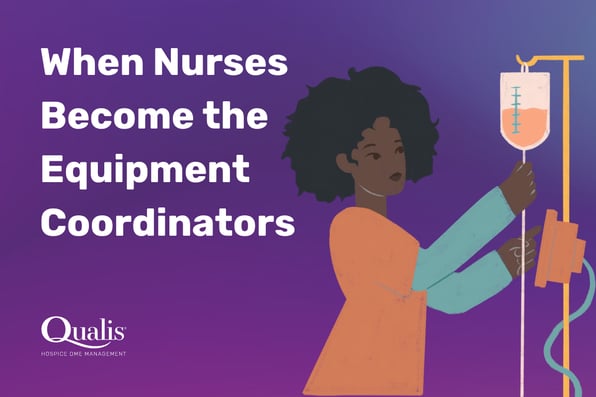When Nurses Become the Equipment Coordinators

Hospice nurses are trained to manage pain, provide emotional support, educate families, and deliver care that honors the final stages of life. What they are not trained for, nor should they be expected to manage, is tracking down equipment, troubleshooting vendor delays, or spending hours coordinating deliveries.
Across the country, this has quietly become the norm.
Nurses are being pulled away from the bedside to handle problems that fall outside their clinical role. Over time, these interruptions add up and chip away at quality of care, job satisfaction, and even the continuity of care itself.
A Quiet Shift from Patient Care to Problem Solving
Every hospice nurse has a story. A bed that did not arrive. An oxygen tank that ran low during a weekend shift. A patient discharge that was delayed while waiting for equipment setup. Nurses often step in to fix these gaps because the alternative is worse. Care is delayed or compromised.
This level of responsibility comes at a cost. When nurses act as the default DME coordinators, they are spending less time assessing symptoms, supporting families, and collaborating with their team. These are the activities that matter most at end of life. They are also the first to fall away when equipment coordination takes over.
Time Lost, Trust Strained
The amount of time clinical staff spend resolving DME-related issues may be larger than many realize. For a hospice with a census of 50 patients, up to 40 hours a week can be consumed by tasks related to ordering, following up, managing issues, and resolving vendor errors.
This work is often invisible, undocumented, and entirely reactive. When things go wrong, patients and families rarely distinguish between the DME provider and the hospice. The nurse becomes the face of the failure.
That creates stress on all sides. Clinical teams carry the emotional weight. Families lose trust. Administrators are left trying to support staff who feel burned out by responsibilities they were never meant to carry.
Where DME Coordination Breaks Down
The cracks usually begin in a few predictable places:
- Unclear roles for who owns follow-up when equipment is late, wrong, or missing
- Fragmented communication between nurses, vendors, and administrative staff
- No consistent system for tracking DME status across shifts and locations
- Weekend or after-hours gaps in support or problem resolution
- Lack of clinical oversight in equipment selection or setup
Nurses know these pain points better than anyone. They are the ones who stay late to make extra calls or wake up to field urgent texts when something is not delivered.
Reclaiming Clinical Time Without Sacrificing Support
The goal is not to add more to the nurse’s plate. It is to remove the wrong things so they can fully focus on what only they can do: patient care.
This starts with taking a fresh look at how DME is managed across the organization. Does the current process protect nurses’ time? Are there clear handoffs between clinical and non-clinical staff? Can nurses trust that equipment will arrive as expected? If the answer to these questions is often “no,” it may be time to consider a more coordinated approach.
Support structures that understand both clinical needs and DME logistics can make a meaningful difference. These are not just systems for placing orders. They are services that stay engaged from the moment a need arises to the moment equipment is picked up and beyond.
Creating Space for Care
When DME is managed in a way that supports rather than distracts from clinical work, several things happen:
- Handoffs during admissions and shift changes become smoother
- Nurses spend less time on follow-up and more time on patient assessment
- Communication with families improves
- Missed or delayed care transitions decrease
- Staff feel more supported and less frustrated
This shift is not about perfection. It is about protection of clinical time, of patient dignity, and of the fragile moments that define end-of-life care.
What Nurses Deserve
Nurses deserve to work in systems that support their expertise. They should not be asked to fill in the gaps created by fragmented DME processes. Their time should be respected. Their focus should remain on the people and families they serve.
Clinical leaders who recognize this often find that the path forward is not about replacing people but repositioning responsibility. They begin to look for ways to offload the non-clinical work without introducing new complexity.
That is where thoughtful DME management comes in. It is not a vendor but a quiet part of the care structure that stays connected, communicates clearly, and solves problems before they reach the bedside.
If your team is feeling the weight of DME coordination, you are not alone. The right support can take it off their shoulders for good.
Want to explore how DME support models can give time back to nurses? Reach out. We are here to listen, and more importantly, to help.

.webp?width=800&height=800&name=CAHPS-Whitepaper_Download%20(2).webp)


